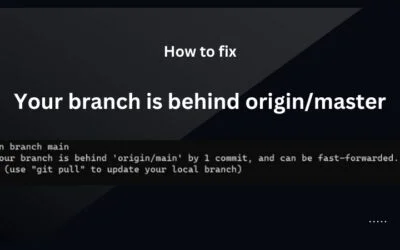When working with Git, encountering errors is not uncommon, and one such error that can be frustrating is “Updates were rejected because the tip of your current branch is behind.”
This error message may leave you scratching your head, wondering what went wrong and how to resolve it.
In this blog post, we will delve into the reasons behind this error and provide step-by-step instructions on how to fix it, ensuring a smooth and successful Git workflow.
Contents
Understanding the Error
The error message “Updates were rejected because the tip of your current branch is behind” indicates that the branch you are trying to merge is ahead of your current branch, and Git is reluctant to perform a simple merge due to potential conflicts in the commit history.
Reasons Behind the Error
There are a few common reasons why this error may occur:
- Outdated Branch: If your current branch is outdated and doesn’t have the latest changes from the remote repository, Git will reject the merge to prevent potential conflicts.
- Parallel Development: The branches involved in the merge might have diverged due to parallel development. This can happen when multiple developers are working on the same codebase independently.
- Force Push: Someone may have force-pushed to the remote branch, causing its commit history to differ from your local branch.
Now that we understand the reasons behind the error, let’s explore some solutions to fix it:
Solution 1: Pull and Merge
- Start by saving any changes you’ve made in your current branch. Stash them or commit them to the branch.
- Run
git pull origin <branch-name>to fetch the latest changes from the remote branch and merge them into your current branch. - If Git can perform a fast-forward merge (i.e., your branch has no new commits since the last pull), the merge will be successful. However, if there are conflicts, you’ll need to resolve them manually.
- After resolving the conflicts, commit the changes, and the merge should now be successful.
Solution 2: Rebase your Branch
- Stash or commit your local changes to the current branch.
- Run
git fetch originto fetch the latest changes from the remote repository. - Use
git rebase origin/<branch-name>to rebase your current branch on top of the remote branch. - During the rebase, you may encounter conflicts that need to be resolved. Follow the prompts to resolve the conflicts.
- After resolving the conflicts, use
git rebase --continueto continue the rebase process until it finishes. - Finally, push the rebased branch to the remote repository using
git push origin <branch-name>.
Solution 3: Force Push (Use with Caution!)
This solution should be used as a last resort and only when you are sure about the consequences. Force pushing rewrites the remote branch’s commit history and can lead to data loss for other collaborators if not used carefully.
- Stash or commit your local changes to the current branch.
- Run
git pull origin <branch-name>to fetch the latest changes from the remote branch. - If you are confident that your local branch is up-to-date, force-push it to the remote repository using
git push -f origin <branch-name>. - This will overwrite the remote branch’s history with your local branch’s history, effectively resolving the error.
Conclusion
Encountering the “Updates were rejected because the tip of your current branch is behind” error in Git can be frustrating, but it’s essential to understand its underlying causes and apply the appropriate fixes.
Whether you choose to merge, rebase, or force-push, always remember to communicate and collaborate with your team to avoid unintended consequences.
With the right approach and a solid understanding of Git workflows, you can overcome this error and maintain a seamless development experience.
Happy coding!





0 Comments